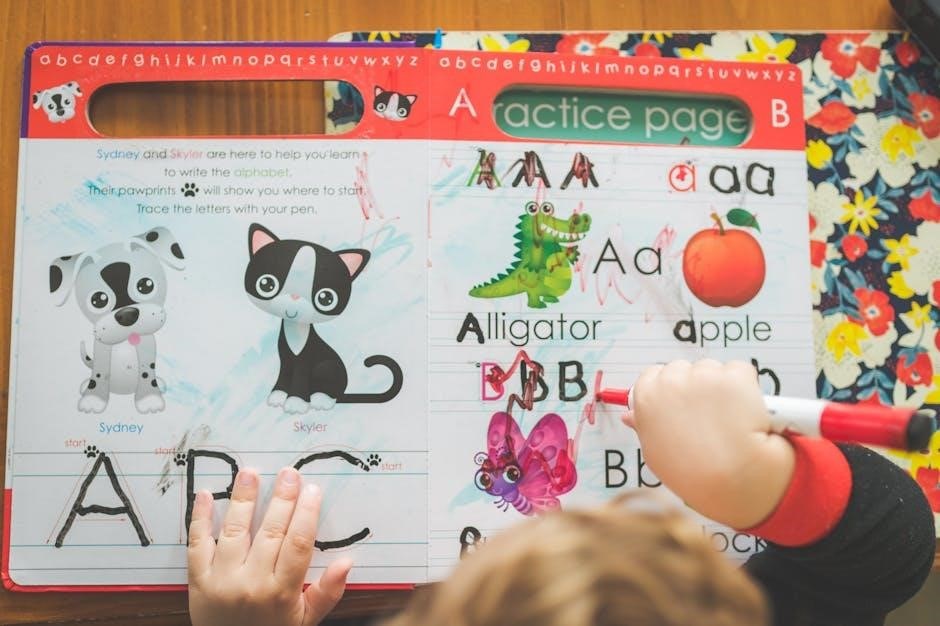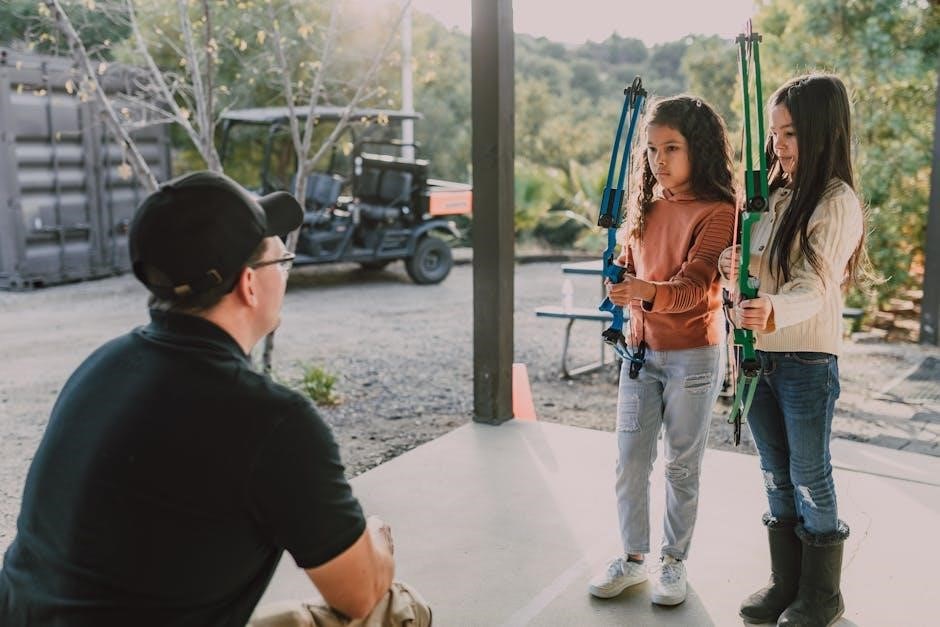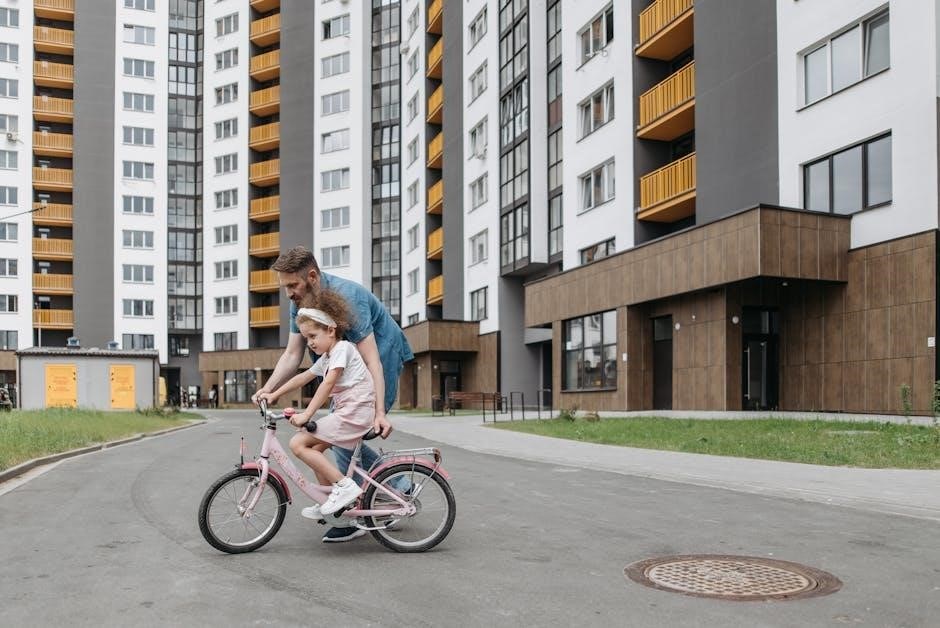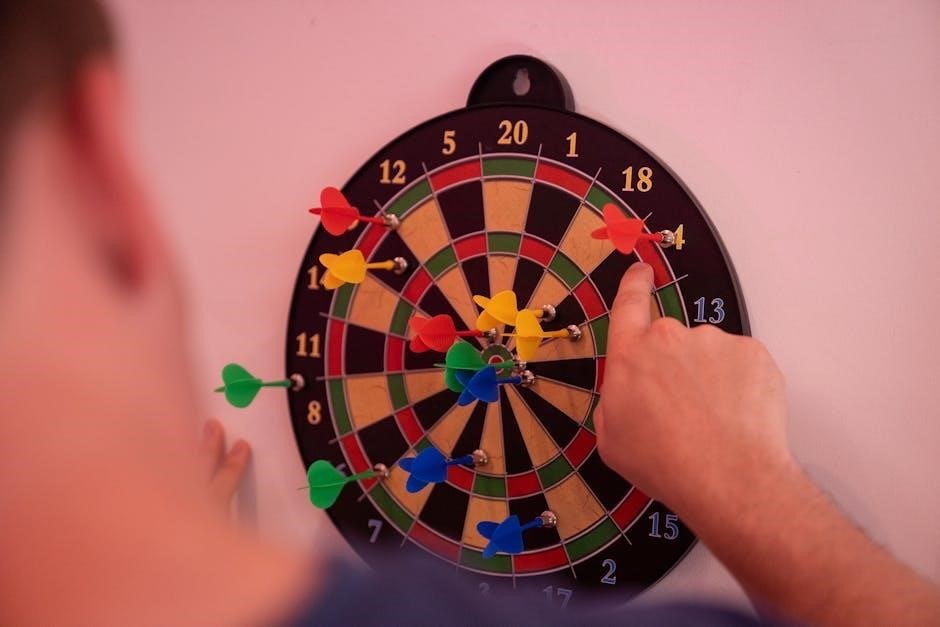realidades 2 capitulo 2a guided practice activities 2a-1 answers
Realidades 2 Capítulo 2A focuses on reflexive verbs‚ daily routines‚ and personal care vocabulary. Guided Practice Activities 2A-1 provide essential exercises to master these concepts effectively.
1.1 Overview of the Chapter

Realidades 2 Capítulo 2A introduces essential Spanish grammar and vocabulary‚ focusing on reflexive verbs‚ daily routines‚ and personal care. The chapter begins with an overview of reflexive verbs‚ explaining their usage and conjugation in the present tense. Students learn to describe personal care activities‚ such as me lavo los dientes (I brush my teeth) or me visto (I get dressed). The vocabulary section emphasizes common phrases related to daily routines‚ like desayunar (to have breakfast) and estudiar (to study). The chapter also includes expressions of frequency‚ such as todos los días (every day) and alguna vez (sometimes). Through structured lessons and interactive activities‚ students build communication skills to discuss their personal habits and schedules effectively.
1.2 Importance of Guided Practice Activities

Guided Practice Activities in Realidades 2 Capítulo 2A are crucial for reinforcing grammar and vocabulary. These exercises provide hands-on opportunities to apply reflexive verbs‚ subject pronouns‚ and present tense -ar verbs in context. By completing activities like fill-in-the-blank sentences and verb conjugations‚ students develop accuracy and confidence. The included answer keys enable self-assessment‚ allowing learners to identify and correct mistakes independently. Regular practice strengthens retention of daily routines and frequency expressions‚ making communication more natural. These structured exercises also prepare students for real-life conversations‚ ensuring they can describe personal care and routines effectively. Consistent engagement with these activities fosters mastery of the chapter’s objectives and improves overall language proficiency.

Key Grammar Concepts in Capítulo 2A
Reflexive verbs‚ subject pronouns‚ and present tense -ar verbs are central to this chapter‚ essential for constructing clear sentences and enhancing communication skills in Spanish.
2.1 Reflexive Verbs: Definition and Usage
Reflexive verbs in Spanish are used to describe actions where the subject performs a task on themselves. These verbs require reflexive pronouns like me‚ te‚ se‚ nos‚ os‚ and se. For example‚ me despierto (I wake up) or él se viste (he gets dressed). Reflexive verbs often involve daily routines or personal care‚ such as lavarse los dientes (to brush one’s teeth) or maquillarse (to put on makeup). Conjugation follows specific patterns‚ with the infinitive ending in -se‚ and the verb stem changing according to the subject. Guided Practice Activities 2A-1 include exercises like fill-in-the-blank and sentence completion to master these verbs. Understanding reflexive verbs is crucial for accurately describing personal actions in Spanish.
2.2 Subject Pronouns and Present Tense -ar Verbs
Subject pronouns in Spanish identify who is performing the action‚ such as yo‚ tú‚ él‚ ella‚ usted‚ nosotros‚ vosotros‚ and ellos. In Capítulo 2A‚ students learn to use these pronouns with present tense -ar verbs‚ which describe routine actions. Regular -ar verbs follow a specific conjugation pattern: the stem remains unchanged‚ and endings are added (-o‚ -as‚ -a‚ -amos‚ -áis‚ -an). For example‚ hablar becomes yo hablo‚ tú hablas‚ and él habla. Guided Practice Activities 2A-1 include exercises like conjugating verbs in context and completing sentences. Common mistakes include confusing endings for tú and usted or forgetting to change endings for nosotros and vosotros. Mastering these concepts is key to forming clear and accurate sentences in Spanish.
2.3 Conjugation Patterns and Common Mistakes
In Capítulo 2A‚ conjugation patterns focus on reflexive verbs and present tense -ar verbs. Common mistakes include incorrect use of reflexive pronouns‚ such as omitting or misplacing them. For example‚ me visto (I get dressed) requires the pronoun me. Students often confuse endings for similar subjects‚ like tú and usted. Another error is forgetting to attach reflexive pronouns to infinitives in sentences like Me despierto a las 8:00 (I wake up at 8:00). Additionally‚ learners may struggle with verbs like se viste (he/she gets dressed)‚ ensuring the pronoun se is correctly placed. Guided Practice Activities 2A-1 address these issues through exercises that reinforce proper conjugation and pronoun usage‚ helping students avoid these pitfalls and improve accuracy in their Spanish communication.

Vocabulary Focus in Capítulo 2A
Capítulo 2A emphasizes vocabulary related to daily routines and personal care‚ such as me despierto (I wake up) and me lavo los dientes (I brush my teeth). Reflexive verbs are central‚ with terms like me visto (I get dressed) and me seeno (I comb my hair). Additionally‚ expressions of frequency‚ such as todos los días (every day) and por la mañana (in the morning)‚ are introduced to describe routines. These vocabulary sets help students communicate about personal care and daily activities effectively in Spanish.

3.1 Daily Routines and Personal Care
Capítulo 2A focuses on vocabulary related to daily routines and personal care‚ introducing essential reflexive verbs like me despierto (I wake up) and me lavo los dientes (I brush my teeth). Students learn to describe personal care activities‚ such as me ducho (I shower)‚ me visto (I get dressed)‚ and me peino (I comb my hair). These verbs are crucial for expressing everyday actions in Spanish. The chapter also includes expressions like por la mañana (in the morning) and antes de dormir (before sleeping) to specify when these routines occur. Guided Practice Activities 2A-1 provide exercises where students fill in sentences with the correct reflexive verbs‚ reinforcing their understanding of these common daily activities and personal care routines.
3.2 Expressions of Frequency and Time
Capítulo 2A introduces essential expressions of frequency and time‚ such as todos los días (every day)‚ cada mañana (every morning)‚ and antes de dormir (before sleeping). These phrases help students describe routines and schedules. Activities like completing sentences with me despierto a las 7:00 de la mañana (I wake up at 7:00 in the morning) reinforce time expressions. The chapter also covers frequency adverbs like siempre (always) and a veces (sometimes)‚ enabling students to communicate habits. Guided Practice 2A-1 includes exercises where students match time phrases with daily routines‚ enhancing their ability to discuss schedules and habits in Spanish. This section is crucial for building clear and detailed descriptions of daily life‚ aligning with the chapter’s focus on personal care and routines.

Guided Practice Activities 2A-1
Guided Practice Activities 2A-1 focus on reflexive verbs and daily routines‚ offering exercises like sentence completion and matching activities to reinforce grammar and vocabulary application.
4.1 Activity Overview and Objectives
Guided Practice Activities 2A-1 are designed to reinforce understanding of reflexive verbs and daily routines. These exercises include sentence completion‚ matching activities‚ and short responses. The primary objective is to help students apply grammar and vocabulary effectively. Activities focus on correct usage of reflexive verbs like me despierto and se lava‚ and vocabulary related to personal care. Students practice describing routines and using expressions of frequency. The exercises also aim to improve sentence structure and communication skills. Answer keys and step-by-step solutions are provided to facilitate self-assessment and mastery of the material. These activities are essential for building confidence in using Spanish accurately and fluently in everyday contexts.
4.2 Step-by-Step Solutions and Explanations
Guided Practice Activities 2A-1 provide detailed step-by-step solutions to help students master reflexive verbs and daily routines. Each exercise is broken down to ensure clarity. For example‚ sentence completion tasks guide students to use correct reflexive verb forms like me despierto or se lava. Conjugation exercises explain how to pair reflexive pronouns with verbs‚ such as yo me lavo or nosotros nos vestimos. Short response questions prompt students to describe routines using vocabulary like cenar or estudiar. The answer key offers explanations for common errors‚ such as incorrect pronoun usage or verb endings. These solutions aim to improve understanding and application of grammar and vocabulary‚ ensuring students can communicate effectively about personal care and daily activities in Spanish.

Answer Key for 2A-1 Activities
The answer key provides correct solutions for all exercises in 2A-1‚ with clear explanations to ensure understanding and improvement in reflexive verbs and daily routines vocabulary.
5.1 Correct Answers and Explanations
The answer key for Guided Practice Activities 2A-1 provides detailed solutions to each exercise‚ ensuring clarity and understanding. Each activity is addressed with step-by-step explanations‚ focusing on reflexive verbs‚ daily routines‚ and personal care vocabulary. Correct answers are highlighted‚ accompanied by grammar rules and examples to reinforce learning. For instance‚ exercises on reflexive verbs like me despierto or él se viste are explained with conjugation patterns and usage tips. Additionally‚ the key offers insights into common mistakes‚ such as incorrect pronoun usage or verb conjugation errors. This resource is designed to help students identify areas for improvement and master the concepts introduced in Capítulo 2A. By reviewing the explanations‚ learners can solidify their understanding and apply the language accurately in real-life situations.

5.2 Common Errors and Tips for Improvement
Common errors in Guided Practice Activities 2A-1 often involve incorrect use of reflexive pronouns and verb conjugations. Students frequently confuse reflexive verbs with regular verbs‚ forgetting to attach pronouns like me or se to infinitives. Another mistake is improper subject-verb agreement in present tense -ar verbs. To improve‚ practice conjugating reflexive verbs regularly and review pronoun placement. Focus on understanding the difference between reflexive and non-reflexive actions. Additionally‚ using flashcards for vocabulary like daily routines can enhance retention. Regularly reviewing grammar rules and completing practice exercises will help minimize errors and strengthen overall proficiency in Spanish.
Additional Resources and Study Tips
Utilize online resources like answer keys and study guides for Capítulo 2A. Practice with flashcards for vocabulary and review grammar rules regularly for better understanding and retention.
6.1 Online Resources for Practice
Several online resources are available to support learning and practice for Realidades 2 Capítulo 2A. The official Pearson website offers guided practice activities‚ answer keys‚ and study guides. Additionally‚ websites like Archive.org provide PDF versions of practice workbooks‚ including answers for 2A-1. Online platforms such as Studocu offer lecture notes‚ summaries‚ and study guides to supplement textbook material. Vocabulary flashcards and interactive grammar exercises are also available on educational websites‚ helping students reinforce their understanding of reflexive verbs and daily routines. These resources are designed to facilitate self-assessment and improve language skills through structured practice and review.
6.2 Effective Study Strategies for Mastery

To master Realidades 2 Capítulo 2A‚ consistent practice and structured study strategies are essential. Begin by dedicating time daily to review grammar concepts‚ such as reflexive verbs and present tense -ar verbs. Use online resources like Pearson’s guided practice activities and answer keys to reinforce understanding. Focus on completing exercises systematically‚ ensuring comprehension before moving to the next topic. Regularly review vocabulary related to daily routines and personal care‚ using flashcards or interactive tools. Engage in active learning by creating sentences with newly learned verbs and expressions. Practice speaking and listening skills through conversations or audio resources. Set specific goals for each study session and track progress. Finally‚ seek feedback from teachers or peers to address areas needing improvement‚ ensuring a strong foundation for future chapters.
Realidades 2 Capítulo 2A effectively teaches reflexive verbs and daily routines. Guided Practice Activities 2A-1 and answer keys provide essential tools for mastering Spanish grammar and vocabulary efficiently.
7.1 Summary of Key Concepts
Realidades 2 Capítulo 2A focuses on reflexive verbs‚ daily routines‚ and personal care vocabulary. Reflexive verbs are actions directed toward oneself‚ such as me despierto or se lava. These verbs require reflexive pronouns like me‚ te‚ se‚ nos‚ and os. The chapter also introduces expressions of frequency‚ such as siempre and normalmente‚ to describe habits. Guided Practice Activities 2A-1 provide exercises to conjugate reflexive verbs in the present tense and use them in context. Vocabulary includes words like cepillarme los dientes and tomarme una ducha‚ which are essential for discussing personal care routines. The answer key offers step-by-step solutions‚ ensuring students understand and apply these concepts correctly. Mastery of these skills enhances communication about daily activities and personal habits in Spanish.
7.2 Final Tips for Successful Learning
To master Realidades 2 Capítulo 2A‚ prioritize consistent practice with guided activities like 2A-1. Focus on understanding reflexive verbs and their pronouns‚ as they are foundational. Use online resources and study groups to reinforce learning. Regularly review grammar rules and vocabulary related to daily routines and personal care. Practice conjugating verbs in context to build familiarity. Utilize the answer key for self-assessment and to identify areas needing improvement. Apply concepts to real-life scenarios to enhance retention. Lastly‚ dedicate time to speaking and listening exercises to improve communication skills. By following these strategies‚ students can confidently grasp the material and achieve long-term proficiency in Spanish.